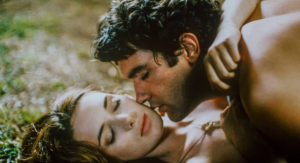“Once I saw it, I was offended: I was offended as a woman, I was offended as a conductor, I was offended as a lesbian…”
Tár, Todd Field’s new film about an eminent female conductor, is splitting the musical crowd. The superstar conductor, woman and lesbian Marin Alsop, was offended in the Sunday Times, while UK conductor Alice Farnham applauded Field in the Guardian, for helping to “normalise the image of a woman on the podium”.
Both responses are quite funny, though arguably Farnham’s response edges it. To watch Tár and leave the cinema thinking that the cause of female conductors has been significantly helped is a bit like thinking that Cinderella generally improves the public image of stepmothers. As played by Cate Blanchett, the film’s protagonist Lydia Tár is a ruthlessly ambitious, amoral narcissist. Major character flaws include deceit, habitual philandering with junior acolytes, and an unrepentant taste for revenge. Not only does she fail every purity test going, she also explicitly rejects attempts to classify her as a “female conductor”, behaving in general much more like a stereotypical man than woman. She insists on being called “Maestro” not “Maestra”, boxes fiercely to work off excess aggression, launches a violent attack on a rival at one point, and at another introduces herself straight-faced as the father of the child she co-parents with her long-suffering wife.
Although Alsop’s negative response to the film is quite different to Farnham’s enthusiastic one, they apparently at least agree that Tár stands or falls by how well it serves the goal of positive representation of female conductors. For her part, Alsop excoriates the director for his “antiwoman” artistic choices, saying: “To have an opportunity to portray a woman in that role and to make her an abuser — for me that was heartbreaking. There are so many men — actual, documented men — this film could have been based on but, instead, it puts a woman in the role but gives her all the attributes of those men.”
Ludicrous as it is to think that, in some alternative universe, the general public might have flocked to cinemas to see propaganda on behalf of the female conducting industry, these responses of Alsop and Farnham are hardly out of step with the zeitgeist. Elsewhere too, there’s a tendency to take a work’s fictional focus upon a particular character as having real-life implications for some wider group, and then to rate the work on that basis. Incorporating a cross-dressing murderer into a novel plot — as did Robert Galbraith (aka J.K. Rowling) in Troubled Blood or Thomas Harris in The Silence of the Lambs — was taken by some to convey something negative about trans people generally, resulting in a quick dismissal for the works in question. More recently, dramatically illuminating the life of a gay serial killer — as the Netflix series Monster did, about the cannibalistic Jeffrey Dahmer — was interpreted as pathologising gay men. (The thoughts of common-or-garden serial killers about how bad the series made them look remain unrecorded.)
There are other signs too that, as a culture, we’re increasingly incapable of reacting to art except in the crudest of moralised or politicised terms. For one, there’s all the trigger warnings and the censored university reading lists. For another, there’s the perceived prohibition on authors writing “outside of their own identities”. Only women should tell stories from the point of view of women, only black people should fictionalise what it’s like to be black, and so on — apparently ignoring the fact that human beings have imaginations, and that it’s a traditional goal of both writing and reading fiction to use them.
And then there’s the habit — seemingly endemic to Gen Z audiences but by no means limited to them — of treating the grossest of personality traits of an artist as relevant to assessing the value of his output, whether or not those traits have left any visible trace on the work. The list of entire oeuvres we are collectively implored to jettison because of the moral transgressions of their creators grows longer every day. Cases like Pound, Polanski, Allen, Hemingway, and Picasso spring to mind, but — such is the degree of churn these days in standards of public decency — practically no artist or creator living prior to 2010 is immune.
This last phenomenon is satirised well in Tár. In a much-discussed scene, the magnificently imperious protagonist runs a conducting masterclass at the Julliard. Asking one nervous student why he didn’t choose to conduct a piece by Bach instead of one by the contemporary Icelandic composer Anna Thorvaldsdottir, he replies: “Honestly as a BIPOC pangender person, I would say Bach’s misogynistic life makes it kind of impossible for me to take his music seriously.”
Tár tries to clarify — “I’m unclear about what his prodigious skills in the marital bed have to do with B minor” — and delicately plays an extract of Prelude No 1 in C major on a nearby piano to underline her point. But the student obstinately doubles down, saying: “You play really well… but nowadays white male cis composers are just not my thing.” Not for nothing has this scene gone viral. For viewers bored of the way that pious professions of faith about identity tend to kill interesting artistic creativity at birth, Tár’s cutting of the foolish young man down to size comes as a something of a relief.
But where did all the furious moralising about art come from in the first place? Perhaps ironically, I think one contributing factor is the instruction from philosophers like Roland Barthes and Michel Foucault to liberate the meaning of an artwork from the jurisdiction of its creator. It might seem strange to link postmodern dehumanisation to the moral panic about art we now see all around us — not least because Barthes and Foucault thought that paying attention to the personality of an artist was reprehensibly bourgeois. But I think a case can be made for the connection, causally at least.
Back in the Sixties, Barthes and Foucault told us that the idea of an author “owning” the meaning of the work he produced was as outdated as the literary humanist tradition that accompanied it. We should stop worrying about what an artist who produced a given work must have intended by doing so. As a concept, the author was now dead or soon would be — skipping blithely over the question of who exactly was telling us this, and why on earth we should take the point seriously if they were right. Henceforth readers would be in control of a work’s meaning and not the author. Like seeing shapes in tea leaves or clouds, whatever patterns a readership saw in a work would be what it meant — for that moment at least.
In effect, the Death of the Author craze — which lasted for decades in literature departments — made people focus on unintended effects of texts rather than intended ones. After all, literary scholars were not about to declare themselves out of a job. The new game became to say what a deracinated text put you in mind of accidentally, and never mind whether there was any likelihood the author might have meant it: feminism in Chaucer, say, or masturbation in the works of Jane Austen. At the same time though, making a professional living from what essentially amounted to prolonged forays into free association apparently left a lot of academics feeling hollow.
Perhaps longing for a more convincing hero’s journey for themselves — or even just something they could unembarrassedly tell relatives about at Christmas — slowly the topic seemed to turn from inadvertent effects of texts generally to inadvertent harms of texts in particular. As a fascinating book review by Merve Emre this week in the New Yorker puts it, the figure of the “Scholar-Activist” was now emerging, who thought “the proper task of criticism was to participate in social transformations occurring outside the university”. Such a critic could position himself as a clearer of literary landmines, finding and disarming them before they went off. What minority group might be hurt by this book? What harmful message might this film convey to the unwary? Though an artist’s actual intentions for her work continued to be treated as irrelevant to assessment of harm, her character defects in general could be cited a potential sources of unwitting contamination for audiences, to be rooted out by brave scholars and exposed to the light.
Against this background, then, Lydia Tár comes across as out of fashion in several senses, despite all the beautiful clothes and glamorous accoutrements. Not only does she refuse to run her personal life according to dictates of priggish grad students, she also cares about getting the meaning of the masterworks she conducts right — right in their own terms, that is, and not just for what good or bad effects might be had on listeners. Time and again in the script, she stresses the importance of looking past the personality defects of composers to try to understand their specific intentions with respect to a work.
Even as the devastatingly funny final scenes unfold, Tár is still asking her orchestra to think about “the composer’s intent”. And as cold-eyed as the film is about the character’s many flaws, there is never any question raised about her enormous talent and artistry. Equally, though, the film does not pretend that enormous talent and artistry ultimately matter that much any more. Of this fact, Farnham and Alsop’s purely transactional takes on Field’s breath-taking artistic achievement are an additional salutary reminder.
Disclaimer
Some of the posts we share are controversial and we do not necessarily agree with them in the whole extend. Sometimes we agree with the content or part of it but we do not agree with the narration or language. Nevertheless we find them somehow interesting, valuable and/or informative or we share them, because we strongly believe in freedom of speech, free press and journalism. We strongly encourage you to have a critical approach to all the content, do your own research and analysis to build your own opinion.
We would be glad to have your feedback.
Source: UnHerd Read the original article here: https://unherd.com/




